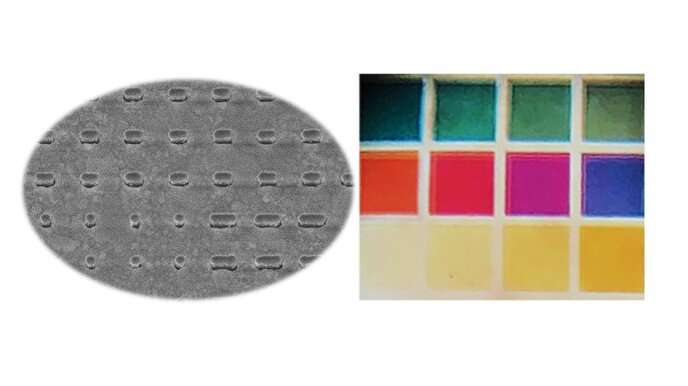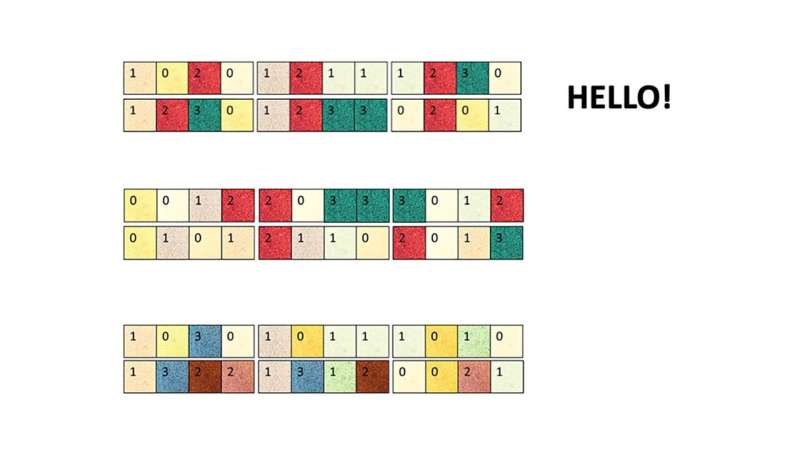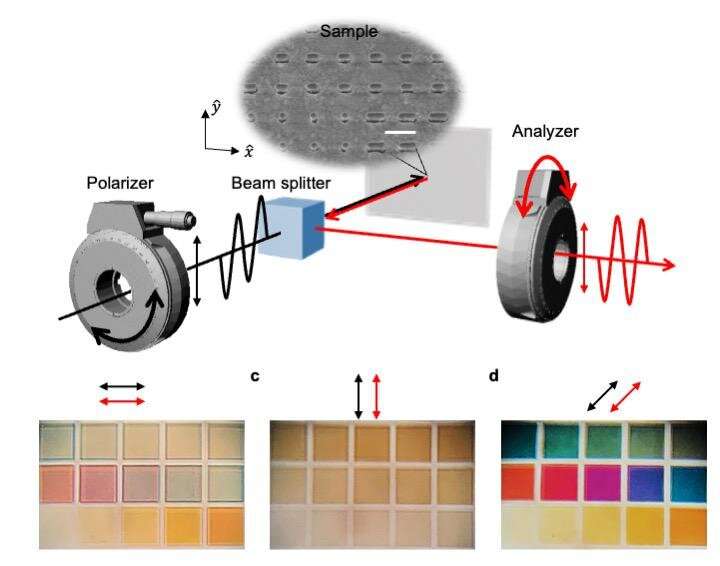Chromo-encryption method uses color to encode information


In a new approach to security that unites technology and art, EPFL researchers have combined silver nanostructures with polarized light to yield a range of brilliant colors, which can be used to encode messages.
Cryptography is something of a new field for Olivier Martin, who has been studying the optics of nanostructures for many years as head of the Nanophotonics and Metrology Lab EPFL’s School of Engineering. But after developing some new silver nanostructures in collaboration with the Center of MicroNanoTechnology, Martin and Ph.D. student Hsiang-Chu Wang noticed that these nanostructures reacted to polarized light in an unexpected way, which just happened to be perfect for encoding information.
They found that when polarized light was shone through the nanostructures from certain directions, a range of vivid and easily-identifiable colors was reflected back. These different colors could be assigned numbers, which could then be used to represent letters using the electronic communication standard code ASCII (American Standard Code for Information Interchange). To encode a secret message, the researchers applied a quaternary code using the digits 0, 1, 2 and 3 (as opposed to the more commonly used binary code 0 and 1). The result was a series of four-digit strings composed of different color combinations that could be used to spell out a message, and the method of chromo-encryption was born.
For example, using their system, the color sequence orange, yellow, red, white represented the digits 1, 0, 2, 0, respectively; a string of numbers which in turn coded for the letter “H’ in the secret test message “Hello!”
“Each color code is not unique, meaning that the same digit—0, 1, 2 or 3—may represent a different color. This means the encryption system is even more secure, because the chance of guessing the correct code sequence is smaller,” Martin explains. The lab’s results have recently been published in the journal Advanced Optical Materials.

A surprising response to light
At the heart of the new method lies the silver nanostructures’ unique reaction to polarized light. The different hues that the researchers observed were first produced by varying the length and position of the nanostructures. Next, the researchers shone polarized light onto them, meaning that the light waves oscillated in controlled directions (vertically, horizontally, or diagonally). Depending on the polarization direction, the light reflected from the nanostructures changed from dull to vivid, yielding robust colors that were then sent through a second polarizer for analysis.
Crucially, in the chromo-encryption method, only the correct combination of polarization directions would reveal the secret message; light polarized in any other direction would reveal a series of colors corresponding to a nonsense message.
Martin explains that to their surprise, the nanostructures exhibited what is known as a chiral response, as they reflected the polarized light in a different direction than the excitation itself. In physics and chemistry, chirality—or the properties of a material that arise from its geometric asymmetry—is an important and well-studied functional aspect of molecules like proteins. But it was not expected to be seen in the symmetrical silver nanostructures.
“Chirality is a concept that is often misused, and is difficult to nail down. The fundamental aspect of chirality in simple geometries like those exhibited by our nanostructures is a key finding of this study.”

Combining technology with the human eye
In addition to encoding messages, the researchers demonstrated that they could use their method to reproduce a painting—in this case, Picasso’s Mediterranean Landscape—at the nanometer scale. To achieve this, they replaced the pixels of a digital reproduction of the painting with their silver nanostructures. Just as with the chromo-encryption method, the artwork was only revealed when light polarized in the correct direction was shone onto the “nano-painting.”
Martin says he believes that the method’s combination of nanotechnology with human visual perception has a lot of potential both for artistic applications and encryption techniques, such as more secure banknotes.
“Nanomaterials and color are at the crossroads of high-tech and artistry, and I find that very appealing. Using nanostructures, you can encode a huge amount of information onto an extremely small area, so there is the potential for very high information density. At the same time, an approach to encryption that can be read and interpreted by the naked human eye, as opposed to a computer, could be advantageous.”
More information:
Hsiang‐Chu Wang et al, Polarization‐Controlled Chromo‐Encryption, Advanced Optical Materials (2023). DOI: 10.1002/adom.202202165
Provided by
Ecole Polytechnique Federale de Lausanne
Citation:
Chromo-encryption method uses color to encode information (2023, February 13)
retrieved 13 February 2023
from https://phys.org/news/2023-02-chromo-encryption-method-encode.html
This document is subject to copyright. Apart from any fair dealing for the purpose of private study or research, no
part may be reproduced without the written permission. The content is provided for information purposes only.



